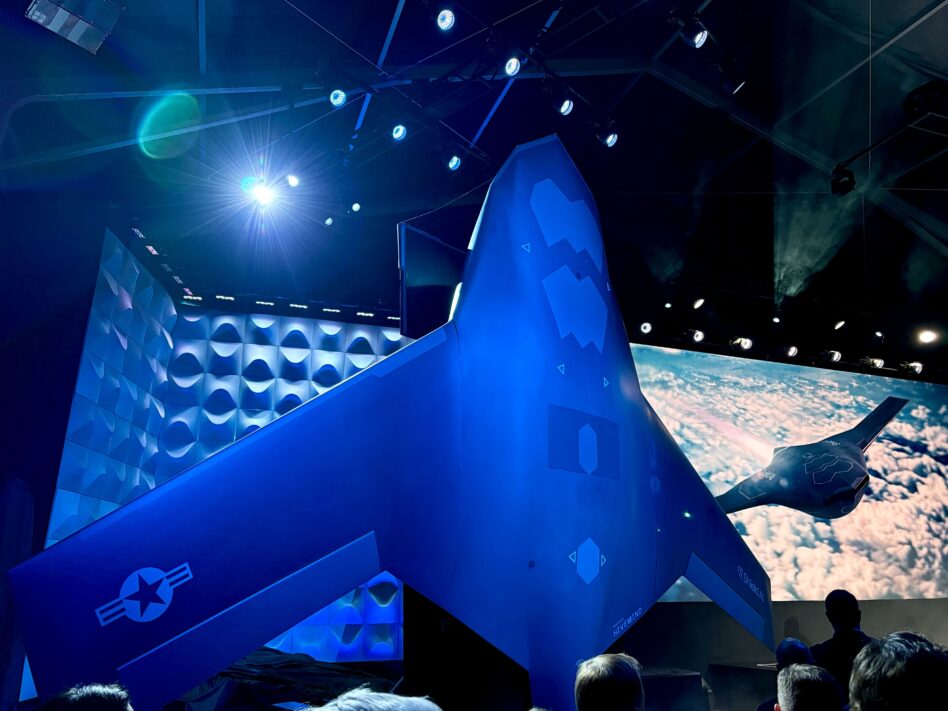Shield AI’s been teasing a big upgrade to its catalog for a while, and we now know what the hype was all about. At a buzzy and smoke machine-heavy unveiling in DC on Tuesday night, Shield AI introduced the world to the X-BAT: A long-range, jet-powered vertical take-off and landing (VTOL) autonomous fighter jet.
As Shield AI co-founder Brandon Tseng said moments before the curtain dropped, “That thing is fucking cool.” We’d have to agree.
Loyal wingmen: We’ve talked about it a lot, but the Collaborative Combat Aircraft (CCA) and Unmanned Combat Air Vehicle (UCAV) world is getting pretty busy, and for good reason. Both the Air Force and Navy have plans to buy a ton of them and make them a key force multiplier for manned aircraft.
So far, the game’s been dominated by General Atomics—which was first to fly and was tapped for both the Air Force and Navy programs—but Anduril’s YFQ-44, Lockheed’s Vectis, Northrop Grumman, and Boeing are all in the race, too. On the other side of the pond, Helsing unveiled its own concept for an autonomous fighter jet, the CA-1 Europa, last month.
Shield your eyes: Shield AI wants to take things up a notch with X-BAT, calling it the “world’s first true standalone autonomous fighter jet” with way more range, payload capacity, multi-mission capability, and power than anything on the market, plus its flagship Hivemind autonomy software at the wheel.
- At 26 feet long and 4.7 feet tall with a 39-foot wingspan, the X-BAT is big for a CCA, but Shield AI says it offers fighter jet capability with a third of the footprint.
- It’s powered by a single afterburning “F-16 class” jet engine, “originally developed for a late 1990s F-15 thrust vectoring program,” SVP of aircraft Armor Harris said at the unveiling, which gives it a 2,000 nautical mile range and a service ceiling of 50,000 feet.
- It has multiple weapons bays (a promo video shows it carrying Long Range Anti-Ship Missiles and AIM-120 Advanced Medium-Range Air-to-Air Missiles) for strike missions on top of ISR payloads.
- Unlike other CCA and UCAV models touted by rivals, it’s a VTOL, which gives it the ability to take off from its launch system on anything from a truck to “ships as small as littoral combat ships” without a runway, according to Harris.
“It’s one of the highest flying and fastest things in the sky, and the design is also inherently stealthy, giving it the signature it needs to survive in modern air combat,” Harris said, and with the added VTOL capability, “X-BAT really is, in many ways, the marriage of a rocket and an airplane.”
All that power and capability lean a wee bit exquisite, but Harris told reporters that it would cost the “same as all the other CCAs.” CNBC reported that Shield AI’s on track to produce the X-BAT for around $27M, which would be a steal compared to current fighter jets if it delivers what they say it will.
Look ma, no hands: Shield AI’s Hivemind software, which powers its signature V-BAT drone and has flown and driven systems from an F-16 to ground vehicles and ships, gives X-BAT the ability to be collaborative and operate in a “network of systems,” but “if that network is not available for whatever reason, it can also hunt on its own,” Harris told The War Zone.
That capability, if Shield’s successful, would be big for force projection and maximization. “At sea, our nation’s nuclear-powered aircraft carriers are the most valuable software and real estate we have,” Tseng said. “Their deck space is precious, and their air wings are deadly. VTOL enables power projection from other ships in the fleet.”
Speedrun: Shield AI’s been moving, like, crazy fast on X-BAT. According to Tseng, the jet’s been under development for just 18 months and they plan to test a VTOL launch for the first time in a year, with full mission capability testing expected in 2028. After those tests, Harris told reporters they’re “generally aiming” to make around “150-plus a year,” with production partners coming out soon.
A lot has to happen before then, but with over $1B in total funding to date, that should give them a lot of runway, even if the X-BAT won’t need one.

